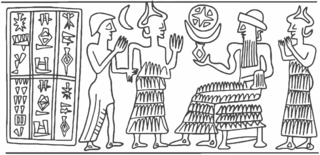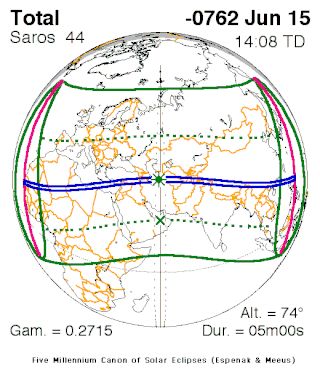
Shalmaneser I was a king of Assyria during the Middle Assyrian Empire. Son of Adad-nirari I, he succeeded his father as king in 1265 BC.
Salmānu-ašarēd II, inscribed mdSILIM-ma-nu-MAŠ/SAG, meaning " Being peaceful is foremost," was the king of Assyria 1030–1019 BC, the 93rd to appear on the Khorsabad copy of the Assyrian Kinglist, although he has been apparently carelessly omitted altogether on the Nassouhi copy.
Shalmaneser IV was the king of the Neo-Assyrian Empire from 783 BC to his death in 773 BC. Shalmaneser was the son and successor of his predecessor, Adad-nirari III, and ruled during a period of Assyrian decline from which few sources survive. As such his reign, other than broad political developments, is poorly known. Shalmaneser's time was marked both by an increase in the power held by Assyrian officials relative to that of the king and Assyria's enemies growing increasingly powerful. Most of Shalmaneser's military efforts were spent warring against the Kingdom of Urartu in the north, which during this time was reaching the peak of its power.
A calendar era is the period of time elapsed since one epoch of a calendar and, if it exists, before the next one. For example, it is the year 2023 as per the Gregorian calendar, which numbers its years in the Western Christian era.

Sargon I was the king during the Old Assyrian period from c. 1920 BC to 1881 BC. On the Assyrian King List, Sargon appears as the son and successor of Ikunum, and the father and predecessor of Puzur-Ashur II.
Ashur-nirari V was the king of the Neo-Assyrian Empire from 755 BC to his death in 745 BC. Ashur-nirari was a son of Adad-nirari III and succeeded his brother Ashur-dan III as king. He ruled during a period of Assyrian decline from which few sources survive. As such his reign, other than broad political developments, is poorly known.
Ashur-dan III was the king of the Neo-Assyrian Empire from 773 BC to his death in 755 BC. Ashur-dan was a son of Adad-nirari III and succeeded his brother Shalmaneser IV as king. He ruled during a period of Assyrian decline from which few sources survive. As such his reign, other than broad political developments, is poorly known. At this time, the Assyrian officials were becoming increasingly powerful relative to the king and at the same time, Assyria's enemies were growing more dangerous. Ashur-dan's reign was a particularly difficult one as he was faced with two outbreaks of plague and five of his eighteen years as king were devoted to putting down revolts.

Aššūr-reš-iši II, inscribed maš-šur-SAG-i-ši, meaning "(the god) Aššur has lifted my head," was the king of Assyria, 971–967 BC, the 96th to be listed on the Assyrian Kinglist. His short five-year reign is rather poorly attested and somewhat overshadowed by the lengthy reigns of his predecessor, Aššur-rabi II, and successor, Tukultī-apil-Ešarra II.
Aššur-nērārī IV, inscribed maš-šur-ERIM.GABA, "(the god) Aššur is my help," was the king of Assyria, the 94th to appear on the Assyrian Kinglist, ruling 1019/18–1013 BC. His short six-year reign was marked by confusion and a dearth of contemporary inscriptions.
Aššur-dān I, mAš-šur-dān(kal)an, was the 83rd king of Assyria, reigning for 46 years, c. 1178 to 1133 BC, and the son of Ninurta-apal-Ekur, where one of the three variant copies of the Assyrian King List shows a difference. The Synchronistic King List and a fragmentary copy give his Babylonian contemporaries as Zababa-šum-iddina, c. 1158 BC, and Enlil-nādin-aḫe, c. 1157—1155 BC, the last of the kings of the Kassite dynasty, but it is probable he was contemporary with two more preceding and two following these monarchs, if the length of his reign is correct.
Ninurta-apal-Ekur, inscribed mdMAŠ-A-é-kur, meaning “Ninurta is the heir of the Ekur,” was a king of Assyria in the early 12th century BC who usurped the throne and styled himself king of the universe and priest of the gods Enlil and Ninurta. His reign overlaps the reigns of his Babylonian contemporaries Adad-šuma-uṣur and Meli-Šipak.
Enlil-nirari was King of Assyria from c. 1327 BC to 1318 BC during the Middle Assyrian Empire. He was the son of Aššur-uballiṭ I. He was apparently the earliest king to have been identified as having held eponym, or limmu, office.

Eriba-Adad, inscribed mSU-dIM or mSU-d10, was king of Assyria from c. 1390 BC to 1364 BC. His father had been the earlier king Aššur-bel-nišešu, an affiliation attested in brick inscriptions, king-lists and a tablet although a single king list gives his father as Aššur-rā’im-nišēšu, probably in error. He succeeded his nephew, Aššur-nādin-aḫḫe II, being succeeded himself by the rather more prominent king Aššur-uballiṭ I, who was his son. He was the 72nd on the Assyrian King List and ruled for 27 years.

The Assyrian eclipse, also known as the Bur-Sagale eclipse, is a solar eclipse recorded in Assyrian eponym lists that most likely dates to the tenth year of the reign of king Ashur-dan III. The eclipse is identified with the one that occurred on 15 June 763 BC.
In the history of Assyria, the eponym dating system was a calendar system for Assyria, for a period of over one thousand years. Every year was associated with the name, an eponym, of the Limmu, the official who led that year's New Year festival.

Erishum I or Erišu(m) Ic. 1974–1935 BC, son of Ilu-shuma, was the thirty-third ruler of Assyria to appear on the Assyrian King List. He reigned for forty years. One of two copies of the Assyrian King List which include him gives his reign length as only 30 years, but this contrasts with a complete list of his limmu, some 40, which are extant from tablets recovered at Karum Kanesh. He had titled himself both as, "Ashur is king, Erishum is vice-regent" and the, “Išši’ak Aššur”ki, at a time when Assur was controlled by an oligarchy of the patriarchs of the prominent families and subject to the “judgment of the city”, or dīn alim. According to Veenhof, Erishum I’s reign marks the period when the institution of the annually appointed limmu (eponym) was introduced. The Assyrian King List observes of his immediate predecessors, “in all six kings known from bricks, whose limmu have not been marked/found”.
Puzur-Ashur II was king during the Old Assyrian period c. 1880 to 1873 BC. Puzur-Ashur II had been both the son and successor of Sargon I. Due to Sargon I's long reign, Puzur-Ashur II came to the throne at a late age since one of his sons, named Ili-bani, was a witness in a contract eleven years before Puzur-Ashur II became ruler. Puzur-Ashur II was succeeded by his son Naram-Sin. The following is a list of the nine annually-elected "limmu" ("eponym") officials from the year of accession of Puzur-Ashur II, the "waklum" ("overseer"), in the limmu of Ashur-iddin to Puzur-Ashur II's death in the limmu of Inaya BC dates are based on a date of 1833 BC for the recorded solar eclipse in the limmu of Puzur-Ištar:
Erishum I or Erišum II, the son and successor of Naram-Sin, was the king of the city-state Assur from c. 1828/1818 BC to 1809 BC. Like his predecessors, he bore the titles “Išši’ak Aššur” and “ensí”. The length of Erishum II's reign is uncertain, however; based on various excavated "limmu" (eponym) lists, Naram-Sin's and Erishum II's reigns had a combined length of 64 years.

Naram-Sin, or Narām-Sîn or –Suen, inscribed in cuneiform on contemporary seal impressions as dna-ra-am-dEN.ZU, had been the "waklum" or "Išši’ak Aššur" of the city-state Assur, listed as the 37th king of Assyria on the later Assyrian King Lists, where he is inscribed mna-ram-dEN.ZU, or a fragmentary list where he appears as -d30. He was named for the illustrious Naram-Sin of Akkad and took the divine determinative in his name Naram-Sin should not be confused with the Naram-Sin who had ruled Eshnunna for around twelve years It is probable that Naram-Sin of Assur was, however, contemporaneous with the earlier part of Ebiq-Adad II’s reign Naram-Sin of Assyria was the son and successor of the short-reigning Puzur-Ashur II, filiation preserved in his seal impression on the envelopes of the waklum-letters to his expat Anatolian-based traders at the karum Kanesh and in the later Assyrian King Lists.

The chronology of the ancient Near East is a framework of dates for various events, rulers and dynasties. Historical inscriptions and texts customarily record events in terms of a succession of officials or rulers: "in the year X of king Y". Comparing many records pieces together a relative chronology relating dates in cities over a wide area.









